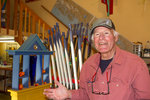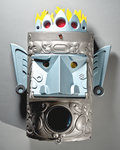After a career in industrial and exhibit design for global brands such as Coleman and Rubbermaid, 3-D artist Les Schnick is now designing for a new client: himself.
This item is available in full to subscribers.
We have recently launched a new and improved website. To continue reading, you will need to either log into your subscriber account, or purchase a new subscription.
If you had an active account on our previous website, then you have an account here. Simply reset your password to regain access to your account.
If you did not have an account on our previous website, but are a current print subscriber, click here to set up your website account.
Otherwise, click here to view your options for subscribing.
* Having trouble? Call our circulation department at 360-385-2900, or email our support.
Please log in to continue |
|


After a career in industrial and exhibit design for global brands such as Coleman and Rubbermaid, 3-D artist Les Schnick is now designing for a new client: himself.
The work is familiar to him and no less hard and some people, looking at his assemblages of industrial products and found natural objects, stumped him with a simple question: ‘Wasn’t this a lot of fun?’
“When people first started asking me that, it took me a little longer to come up with the answer because I had mixed feelings about what they were expecting for an answer and how I really feel about it,” Schnick said. “ I am really clear about it now. Usually it is not fun. It is work.”
Albeit a different type of work, he said.
“The client is me now instead of somebody else with a lot of money. All of the decisions good or bad, I am responsible for. I can’t blame the builder who I was designing for or the owner who insisted for their budget.”
Working out of his Port Townsend studio, Schnick, 74, creates about three new pieces every two months, he said, adding he is inspired by often overlooked items.
“I like to bring things that are common to us that we recognize, but show them in a new way that you never saw them before and combine them with other things, whether it was from nature or if it was from industry,” he said. “When I say industry I mean anything that we humans made and then cast off as junk.”
It is a time-honored impulse, going back to the ground-breaking “Machine Art” show at the New York Museum of Modern Art, where the architect Philip Johnson in 1934 celebrated industrial design by curating a show of car pistons, beakers, springs and other common machine-made items designed by humans. The art world was aghast, but by the 1960s had embraced design as art.
Schnick’s studio is packed with random items he picked up at various locations, a small-scale museum of human and natural design.
Now semi-retired from industrial design, Schnick says he creates to express himself, not necessarily for any fun associated with the process.
It is when Schnick’s work is admired by others that he feels the effort was worthwhile.
“The fun comes when you get recognition,” he said.
And receive recognition Schnick has.
2019 CVG Show award
A piece created by Schnick, titled “God of Fire,” recently received first place in the 3D category of the 12th annual Washington State Juried Art Competition and Show in Bremerton at the Collective Visions Art Gallery.
“The CVG Show is a statewide juried art show, and as such is one of the largest and most competitive juried art shows in the state,” said Alen Neuberg, a founding member of CVG. “Any one entry has less than a one in eight chance of even being accepted. There were five artists from Port Townsend and two from Port Hadlock in the show.”
Just to be able to enter his piece, which is between two and three feet tall, was astounding, Schnick said.
“Ninety-three communities were represented by artists who applied. There were 1,060 entries and 131 got in. Just to get in is a big deal.”
Schnick was incredulous when he learned his piece earned the top award.
“I didn’t ever expect it to happen,” he said. “My wife was there sitting next to me and some friends. I didn’t know it was going to happen but I am sure I turned 27 shades of red. I had a baseball cap on, and my wife took it off and said, ‘You are not going up there with a baseball cap on.’ She kissed me on the cheek and then I went up.”
Creating the piece
“God of Fire” started life as the door of a cast iron stove, Schnick said.
“I used to have a cabin over on Lake Pend Oreille in Idaho. It is an old silver mining place and gypsum, too. You walk around the woods and you find old stuff. This was left there and when we sold the cabin last year, I kept it.”
Schnick didn’t know what to do with the discarded metal at first.
“I started messing with it and then I cleaned it up and sealed it with penetrating epoxy to stabilize any rust that was there,” he said.
Although it appears similar to an iron Tiki god, Schnick said there was no intention on his part to base the piece off of any existing culture in the world, past or present.
“No theme was in my mind when I did it. I just started thinking about a stove and fire and so I made up a god of fire,” he said. “Sure, all of us have been exposed to the South Pacific and Pacific Northwest (culture), and other things from art history, so it just collectively became what it is.”
After painting the piece a metallic silver, Schnick set about making it look as if there were a fire lit inside it.
“I put LED lights and a battery pack inside,” he said. “It would shine down on the interior. I took pictures of my own wood stove burning to get the flames to see which one really worked and then I glued it in there, so when it is turned on … you can see the flames in there.”